Candida auris is a dangerous fungal infection that emerged in Japan in 2009 and has now spread round the world, especially in hospitals. It is a superbug, a germ that has evolved defences against medicines and cannot be treated. These include antifungals such as fluconazole (Diflucan), the antifungal drug of choice in many countries, and recently introduced antifungals known as echinocandins. [caption id=“attachment_5260811” align=“alignleft” width=“380”]  Representational image. Getty Images[/caption] First identified in Japan in 2009 after isolation from a patient’s ear, it is responsible for the rapidly increasing, hospital-acquired, invasive infections worldwide. It is a threat to intensive care units, because it can survive normal decontaminants such as chlorhexidine and bleach. Some hospitals have had to rip out floor and ceiling tiles to get rid of it. If it enters the bloodstream, it can be life threatening. People with weakened immune systems are the most vulnerable — newborns, the elderly, people who have other infections, diabetics, people who have undergone antibiotic or antifungal therapy. The rise of C. auris has been little publicised, in part because it is new. Outbreaks have been kept confidential by hospitals, doctors, even governments, as publicising them would scare people into not going for other treatments. In America, the Centre for Disease Control is not allowed to make public the name of hospitals involved in outbreaks. The symptoms of C auris — fever, aches, fatigue — are not unusual, making it hard to recognise the infection without testing. It is frequently misdiagnosed. One sign is that fever and chills don’t subside after being treated with antibiotics. Coma, organ failure and death may occur if appropriate treatment is delayed. Around 30-50 percent of patients who contract Candida auris die. The fungus can live for a long time on patients’ skin, and in health care facilities, allowing it to spread to new patients. Why is it spreading so rapidly across the globe ? 1. One reason is the indiscriminate doling out of antibiotics and antifungals by the medical community. This allows microbes to adapt, evolve and outsmart drugs. Without antimicrobials that work, common medical procedures, like hip operations, C-sections, or chemotherapy, have become more dangerous, and medical interventions — organ transplants, chemotherapy — may become impossible to survive. Gonorrhoea, certain strains of tuberculosis to name a few, no longer respond to any medicine. 2. The more important reason is that each country uses the same drugs on animals grown for food. In India we use tonnes of antibiotics and antifungals in poultries and piggeries. Animals are forcibly grown in such terrible conditions that keeping them alive, till they are large enough to be killed, is impossible without the use of antibiotics and antifungals. This applies in India mainly to the poultry industry, in which mite-infested birds are overstuffed in filthy cages with their beaks and toes cut off and are fed rubbish. Their antibiotic/antifungal laced faeces spreads in land and water. We eat contaminated food and drink contaminated water. Eighty percent of India’s antibiotics are used to promote livestock and poultry growth, and to protect the animals from the bacterial consequences of the filthy environments in which they are grown. In America, antibiotics worth 34 million pounds a year are used. In India it is more than this figure. According to the latest WHO surveys, India is the largest user of antibiotics and fungicides in the world – and is also the country that originated the germ resistant to all medicine — the superbug. 3. Modern agricultural practices also depend on these drugs. C. auris’s resistance is traceable to industrial agriculture’s mass application of fungicides used in diverse crops like wheat, banana, barley, soyabeans, apples, grapes, soft fruits, corn, among others. In a paper titled “Worldwide emergence of resistance to antifungal drugs challenges human health and food security” published in Science 2018 by scientists Matthew C Fisher and his colleagues, six main classes of fungicides — azoles, morpholines, benzimidazoles, strobilurins, succinate dehydrogenase inhibitors, anilinopyrimidines — have been identified, which were hardly used in agriculture before 2007. It is not a coincidence that the fungi affecting us have all turned into superbugs in that period. Azoles, used in both crop protection and medical settings, are broad-spectrum fungicides, annihilating a wide range of fungi rather than targeting a specific type. They are now 26 percent of all fungicides used. Candida auris is not the only deadly fungus which is showing multidrug-resistance. One fungus, Aspergillus fumigatus, has been killing two lakh people every year. This species colonises decaying vegetation in fields, forests, and compost heaps. It attacks immunocompromised humans. Azole antifungals itraconazole, voriconazole, and posaconazole have long been used to treat pulmonary asperillogosis, the infection caused by A. fumigatus, but in the last ten years it has developed a resistance to antifungal drugs. Studies, comparing long-term azole users and patients just beginning to take the drug, have shown that drug-resistant A. fumigatus was prevalent in both groups, showing clearly that the resistance has come from the food they are exposed to, rather than the medicines they were taking. Studies done in Bogota, Columbia, found A. fumigatus in agricultural fields using fungicides. Soils were sampled from an array of crop fields treated with itraconazole or voriconazole fungicides. A. fumigatus was grown in the lab on agar treated with the same antifungals. In more than 25 percent of cases, A. fumigatus persisted despite the fungicide treatment. This simply means that, due to agricultural practices, Aspergillus is entering hospitals already adapted to the antifungals designed to check its spread. Drug resistant strains of Candida albicans, C. glabrata and Cryptococcus neoformans, have also been recently reported. Candida glabrata has become the main bloodstream pathogen recovered from patients. There is also a growing threat from pathogenic fungi such as Aspergillus terreus, Scedosporium spp., Fusarium spp., and members of the Mucorales. Azole fungicides need to be banned in crop management. The dangers of continuing upon this path of agricultural management are acute. Twenty-five forms of agricultural azoles are in use, compared to just three forms of medical azoles. Obviously, the medical use of azole-based antifungals is ineffective. Azoles are increasingly failing as frontline therapies, with patient mortality approaching 100 percent. The rate of emergence of fungicide resistance is greater than the pace of fungicide discovery. This situation parallels the situation for antibiotics But, instead of intervening in the interests of public health to limit azoles, government policy in recent years has promoted their expansion, fostering conditions for virulent drug-resistant fungi. Global sales have tripled since 2005, from $8 billion to $21 billion in 2017. Azoles are used not only for human and animal health care and crop protection, but also in anti-fouling coatings and timber preservation. Fungicides have expanded in sales and in geographic distribution. In each new area fungicides percolate into the local environment. In 2012, United States Geological Survey(USGS) scientists studied 33 different fungicides used in potato production and found at least one fungicide in 75 percent of surface water and 58 percent of ground water samples. As climate change brings higher overall temperatures and vacillation between drought and heavy rainfall, fungi will spread outside their current ranges. Aspergillus flavus, the producer of a cancer-causing aflatoxin that reduces corn yields and poisons humans, thrives in drought conditions and large crop-water deficits. Instead of governments blaming farmers for illiterate overuse, or using this opportunity to get more gene-manipulated seeds, or looking at different drug cocktails that will spew more poison into the environment, agricultural practices will have to be modified to bring back organic food, sustainable crop rotation and inter-cropping. There is enough evidence to show that this can greatly reduce the presence of fungal diseases. For instance, inter-cropping soya with flax removes all pathogenic fungi. Researchers in India find that if, instead of using azole fungicide to control potato blight, silica is applied to the leaves, disease infestation comes down sharply. Surrounding crops, with wild non-crop vegetation, also controls fungal pathogens. We are in a vicious spiral. As we use more fungicides, more and more resistant pathogenic fungi emerge. Fungi have highly plastic genomes and adapt rapidly. We are seeing the continual emergence of new races of plant-infecting fungi able to overcome both host defences and chemical treatments. The first case of resistance against the benzimidazoles (MBCs) was reported in 1969, and now MBC resistance is known to occur in more than 90 plant pathogens. Azole resistance in a plant pathogen was first reported in 1981. Resistance to strobilurins was reported in field trials even before commercial introduction, and in wider field populations within 2 years of release. A new generation of succinate dehydrogenase inhibitors was introduced in 2007, but by 2017, resistance were found in 17 pathogen species. Today, crop-destroying fungi account for 20 percent of annual yield losses worldwide, with a further 10 percent loss post-harvest. By doing intensive farming, and using broad-scale pesticide applications, we breed out the plants’ own defences. In parallel, the number of humans at risk from fungal infections is rising rapidly. To avoid a global collapse in our ability to control fungal infections, and to avoid critical failures in medicine and food security, we must put public health before company fiscal health. The global mortality rate for fungal diseases now exceeds that for malaria or breast cancer, and is comparable to those for tuberculosis and HIV. But no Indian government has even applied its mind to this huge problem. The pesticide ministry is in one corner, far away from the health ministry, and the two have never met to discuss issues like this. To join the animal welfare movement contact gandhim@nic.in, www.peopleforanimalsindia.org
To avoid a global collapse in our ability to control fungal infections, and to avoid critical failures in medicine and food security, we must put public health before company fiscal health
Advertisement
End of Article


)

)
)
)
)
)
)
)
)



